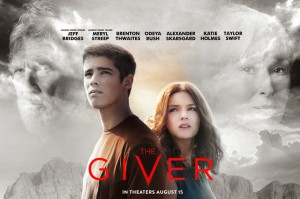Reilly Van Dyke, Staff Writer

Directed by Phillip Noyce and based off the 1994 Newbery Medal award winning novel by Lois Lowry, “The Giver” was released in theaters on August 15. Starring Jeff Bridges, Meryl Streep, Alexander Skarsgard and Katie Holmes, with a brief appearance by musician Taylor Swift, “The Giver” tells the story of an idyllic, utopian society where all pain, differences and life challenges have been completely erased. But with this comes the complete eradication of all things beautiful, as well as feelings of joy and happiness.
In this future society, the citizens are separated into communities. Brenton Thwaites portrays Jonas, the protagonist who is assigned to be the new receiver of memory upon his high school graduation. While his friends are given common career assignments, there can only be one receiver of memory. The person for this position is chosen very carefully by the elders, who act as a form of governing power over the community. The receiver of memory is given memories of the way the world used to be, before it was made to be perfect.
Without giving too much away, the movie has a lot of intense action scenes, as Jonas tries to figure out what the world used to be like and what he, his family and his friends are being sheltered from. Realizing his world is full of hypocrisy, lies and completely lacking in any real emotion, Jonas attempts to reveal the truth about the world to his community. Living in a society where pain and hatred have been left out, Jonas comes to realize that his freedom to choose has also been dismissed.
Having read the book myself, which is aimed at a middle school/young high school audience, I feel that the movie stayed true to it. The only real noticeable differences were that the society in which Jonas, his family, and his two best friends, Fiona and Asher, inhabit seems more futuristic than the original story. The characters are also younger in the book, instead of high school graduates.
The movie raises some important ethical and philosophical questions, like how much control a government should have over its people. Part of the community’s idea of incorporating “sameness” includes getting rid of colors, races and other strange rules, like not allowing identical twins. Individual rights have been abolished, not as a punishment, but rather as a way to protect the citizens from making choices the elders would consider selfish and weak. By eradicating war, natural disasters, famine and poverty, they can prevent chaos and destruction.
Stated in a review from Townhall.com, “Just as we see in contemporary times, with closed societies like North Korea, the community members in ‘The Giver’ have the disadvantage of not knowing an alternative to the life they are being forced to lead. They are conditioned to eliminate comprehension of an alternative world that allows individuals the freedom of choice.”
Ultimately, “The Giver” is a cautionary tale of what could become of a society that doesn’t question their beliefs, their government and their freedoms as citizens.
Leave a Reply